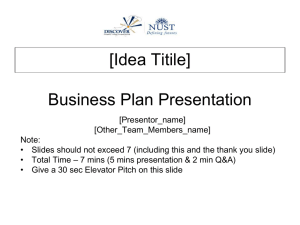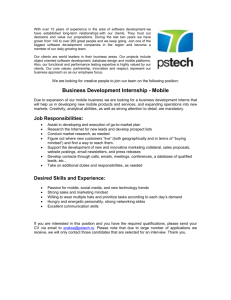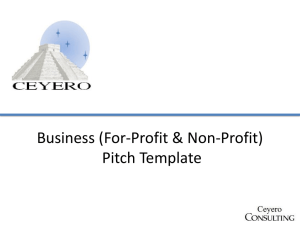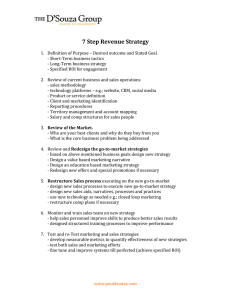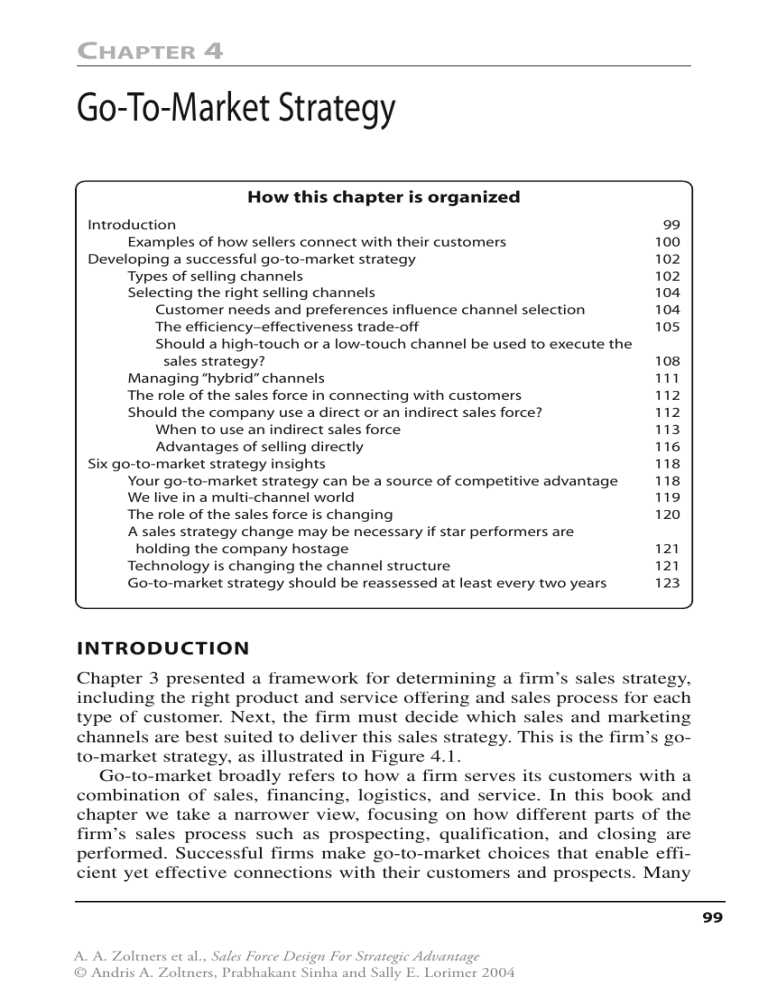
CHAPTER 4 Go-To-Market Strategy How this chapter is organized Introduction Examples of how sellers connect with their customers Developing a successful go-to-market strategy Types of selling channels Selecting the right selling channels Customer needs and preferences influence channel selection The efficiency–effectiveness trade-off Should a high-touch or a low-touch channel be used to execute the sales strategy? Managing “hybrid” channels The role of the sales force in connecting with customers Should the company use a direct or an indirect sales force? When to use an indirect sales force Advantages of selling directly Six go-to-market strategy insights Your go-to-market strategy can be a source of competitive advantage We live in a multi-channel world The role of the sales force is changing A sales strategy change may be necessary if star performers are holding the company hostage Technology is changing the channel structure Go-to-market strategy should be reassessed at least every two years 99 100 102 102 104 104 105 108 111 112 112 113 116 118 118 119 120 121 121 123 INTRODUCTION Chapter 3 presented a framework for determining a firm’s sales strategy, including the right product and service offering and sales process for each type of customer. Next, the firm must decide which sales and marketing channels are best suited to deliver this sales strategy. This is the firm’s goto-market strategy, as illustrated in Figure 4.1. Go-to-market broadly refers to how a firm serves its customers with a combination of sales, financing, logistics, and service. In this book and chapter we take a narrower view, focusing on how different parts of the firm’s sales process such as prospecting, qualification, and closing are performed. Successful firms make go-to-market choices that enable efficient yet effective connections with their customers and prospects. Many 99 A. A. Zoltners et al., Sales Force Design For Strategic Advantage © Andris A. Zoltners, Prabhakant Sinha and Sally E. Lorimer 2004 Sales Force Design for Strategic Advantage 100 Sales and marketing channels Value-added partners Agents/ Direct TeleE-channels distributors/ sales force channels retailers Advertising & promotion FIGURE 4.1 Go-to-market activities in the sales force design framework industries have evolved from viewing the sales channel as consisting of a talking tape recorder (the salesperson) and a delivery truck, and now view the sales channel as a way to add customer value to the firm’s products and services. Go-to-market strategies use resources from both inside and outside the company. Inside resources include a company’s direct sales force, product specialists, service specialists, telesales personnel, and e-channels. Outside resources include collaborators, co-suppliers, partners, wholesalers, distributors, independent agents, value-added resellers, and retail outlets. Companies creatively combine the use of internal and external resources to execute their sales strategy in order to reduce the cost of connecting with customers and, at the same time, to enhance customer impact. Sales forces, whether company-owned (direct) or independent (indirect), often play an important role in this connection. Examples of How Sellers Connect with their Customers The following three examples illustrate different ways that companies go to market. Figure 4.2 shows how a networking equipment manufacturer goes to market. This company sells a very technical, complex, and customized product that has high value and high risk for the customer. Thus, a highly specialized sales force is used to serve the customers. Salespeople specialize both by market and by task. Figure 4.3 illustrates how an office products supplier goes to market. Compared with the products of the networking equipment manufacturer, this company’s products are simpler, low risk, and do not require customization. Thus, it is not necessary for a highly specialized sales force to be involved in every step of the selling process. The office products supplier uses a direct mail catalog and telemarketing to generate and qualify leads. Both of these selling channels are much less expensive than a direct sales force. Generalist salespeople participate in selling to qualified leads and in closing sales. Product specialists are used only to sell the
